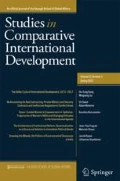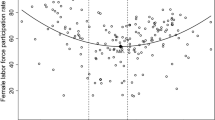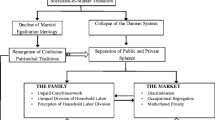Abstract
This paper challenges and complements the view, widely held in sociological labor studies, that incomplete proletarianization weakens labor’s bargaining power in the city by allowing capital to externalize the costs of labor reproduction to the countryside. The authors argue instead that the preservation of migrant workers’ links to the rural economy plus rural development measures can, under certain circumstances, empower labor by increasing their marketplace bargaining power. Beginning with the puzzle of migrant labor shortages in China, and based on national data and a case study, the authors show that access to land and pro-rural state policies in the first decade of the twenty-first century together stimulated rural development in hinterland China and created more employment opportunities in agricultural and local nonfarm sectors. As a consequence, rural (migrant) laborers in China were able to rely on rural employment and choose not to participate in labor migration, thus contributing to the labor shortage and pressing employers in the city to increase wage rates and improve working and living conditions.









Similar content being viewed by others
Notes
Hukou refers to household registration in China. For a detailed discussion, see Wang (2005).
Rural development in this paper refers to rural economic development that leads to the growth of rural economy and the creation of more employment opportunities.
Provincial units refer to jurisdictional units directly governed by the central government, and include provinces, ethnic autonomous regions and municipalities (i.e., Beijing, Tianjin, Shanghai and Chongqing).
The National Bureau of Statistics of China has adjusted the total number of rural laborers in 2009 to 425.1 million based on the newest census (NBSC 2011a: Chapter 4-2). This adjustment does not alter the general picture of the Chinese rural labor force that we present here, however.
The Bureau adopts a broad definition for migrant workers. Rural laborers are seen as migrant workers if they work outside their townships for 1 month or longer.
For detailed analysis of how TVEs changed the Chinese rural economy, please see Oi (1999).
A 1995 national survey showed that 97 % of rural households derived some of their income from agriculture (Knight and Song 2003).
The number is estimated based on the available data of the two sources on labor migration between 2002 and 2006. The Ministry of Agriculture reported that the number of rural migrant workers had increased from 94,000,000 in 2002 to 115,000,000 in 2006, whereas the National Bureau of Statistics reported that it increased from 105,000,000 to 132,000,000 for the same period (Han et al. 2009: 7). Thus, we estimate that the number of migrant workers in the definition of the Ministry of Agriculture was 125,000,000 in 2009.
NBSC (2011b: 14–17).
The real names of count, townships, and villages are replaced with roman capital letters.
One hectare equals 15 mu.
A village team consists of 20–30 households, and a village usually has a few to a dozen of village teams.
Household interview, April 8, 2006.
We see rural laborers who work outside H county for at least 3 months a year as migrant workers. This definition is narrower than official definitions, which see rural laborers as migrant workers as long as they work outside their townships.
Household interview, April 7, 2006.
In village D, where there was rural industry, the situation was better because rural laborers could still derive their income from making fireworks, which was comparable to that of migration.
Household interview, March 21, 2006.
Mr. Zhang was born in 1965 and his wife in 1963. We interviewed them on March 10, 2011.
The drought did not have as great an impact on village D because peasants in the village relied on the industry of fireworks manufacture for their main source of income.
It is worth noting that our definition of migration is narrower than official statistics and only includes people who leave the county in search of employment for at least 3 months a year.
Household interview, September 15, 2005.
Household interview, March 23, 2006.
Local official interview, July 17, 2008.
Household interview, July 22, 2008.
Local official interview, September 20, 2005.
Local official interview, July 17, 2008.
Household interview, March 6, 2011.
The land system is now falling apart in many parts of China as local governments take land from peasants and give it to large agrarian companies or urban real estate developers. The land grab has also occurred in H county, but has so far remained small scale.
Arrighi et al. (2010) argues that the dispossession of agricultural producers from the land in South Africa had lowered the quality of the labor force and reduced welfare for the majority of the population.
References
Alexander P, Chan A. Does China have an apartheid pass system? J Ethnic Migr Stud. 2004;30(4):609–29.
All-China Information Center for the Market of Human Resources (Zhongguo renli ziyuan shichang xinxi jiance zhongxin). 2011 niandu quanguo bufen chengshi gonggong jiuye fuwu jigou shichang gongqiu zhuangkuang fenxi (An analysis of the market supply and demand of labor in city public employment service institutions in selected cities nationwide in the year of 2011). Available at http://www.lm.gov.cn/DataAnalysis/content/2012-03/06/content_699309.htm. 2012.
Arrighi G, Aschoff N, Scully B. Accumulation by dispossession and its limits: the Southern Africa paradigm revisited. St Comp Int Dev. 2010;45:410–38.
Burawoy M. The functions and reproduction of migrant labor: comparative material from southern Africa and the United States. Am J Sociol. 1976;81(5):1050–87.
Cai F, et al. The coming Lewisian turning point and its policy implications. Beijing: Social Sciences Academic; 2007.
Chan A. A ‘race to the bottom’ globalisation and China’s labour standards. China Perspect. 2003;46:42–9.
Chan KW, Buckingham W. Is China abolishing the hukou system? China Q. 2008;195:582–606.
Chen X. Shixi xinjieduan de nongcun, nongmin he nongye wenti (a trial analysis of the problems of the countryside, peasants and agriculture). Macroecon (hongguan jingji). 2001;36:12–26.
Cheng T, Selden M. The origins and social consequences of China’s hukou system. The China Quarterly. 1994;139:644–68.
H county Bureau of Statistics. H county Statistical Yearbook 2007. Inner Mongolia: H county Bureau of Statistics; 2007.
H county Bureau of Statistics. H county Statistical Yearbook 2008. Inner Mongolia: H county Bureau of Statistics; 2008.
Han J, et al. Zhongguo nongmingong xianzhuang jiqi fazhan qushi zongbaogao (a general report on status quo and development trend of peasant workers in China). Reform (gaige). 2009;2:5–27.
He X. Yeshuo mingong huang (rethink migrant labor shortage). Available at http://www.snzg.cn/article/2011/0224/article_22361.html . 18 February 2011.
Huang Y. Capitalism with Chinese characteristics: entrepreneurship and the state. Cambridge and New York: Cambridge University Press; 2008.
Huang P, Zhan S. Internal migration in China: linking it to development. In: Migration, development and poverty reduction in Asia. Geneva: International Organization for Migration; 2005. p. 65–84.
Jingji Cankao Bao [Economic Information Daily]. Laodong wenti zhuanjia pojie mingonghuang jigonghuang (Labor experts resolve the issues of the shortage of migrant and skilled workers). 9 September 2004.
Knight J, Song L. Chinese peasant choices: migration, rural industry or farming. Oxf Dev Stud. 2003;31(2):123–47.
Lee CK. Against the law: labor protests in China’s rustbelt and sunbelt. Berkeley and Los Angeles: University of California Press; 2007.
Li C. Wo xiang zongli shuo shihua (I tell the premier minister the truth). Beijing: Guangming ribao chubanshe; 2002.
Liu Z. An empirical study of mingong shortage. China Opening Herald. 2008;139:84–90.
Mcmichael P. Peasant prospects in the neoliberal age. New Polit Econ. 2006;11(3):407–18.
Mo R. Laodongli gongdayuqiu zhuangkuang xia de mingong he jigong duanque (The shortage of migrant and technical laborers while laborers’ supply exceeds demand). In: Xin RU, editor. Analysis and forecast on China’s social development. Beijing: Social Sciences Academic; 2004. p. 260–72.
Moyo S, Yeros P. The resurgence of rural movements under neoliberalism. In: Moyo S, Yeros P, editors. Reclaiming the land: the resurgence of rural movements in Africa, Asia and Latin America. London: Zed Books; 2005. p. 8–66.
National Bureau of Statistics of China. China rural statistical yearbook 1991. Beijing: China Statistical Press; 1991.
National Bureau of Statistics of China. China rural statistical yearbook 2001. Beijing: China Statistical Press; 2001.
National Bureau of Statistics of China. China yearbook of rural household survey 2003. Beijing: China Statistical Press; 2003.
National Bureau of Statistics of China. China rural statistical yearbook 2005. Beijing: China Statistical Press; 2005.
National Bureau of Statistics of China. 2009 nian nongmingong jiance diaocha baogao (The monitoring report on rural migrant labor in 2009). http://www.stats.gov.cn/tjfx/fxbg/t20100319_402628281.htm. 2010a.
National Bureau of Statistics of China. China yearbook of rural household survey 2010. Beijing: China Statistical Press; 2010b.
National Bureau of Statistics of China. China rural statistical yearbook 2010. Beijing: China Statistical Press; 2010c.
National Bureau of Statistics of China. China population and employment statistics yearbook 2010. Beijing: China Statistical Press; 2010d.
National Bureau of Statistics of China. China statistics yearbook 2011. Beijing: China Statistical Press; 2011a.
National Bureau of Statistics of China. China rural statistical yearbook 2011. Beijing: China Statistical Press; 2011b.
Naughton B. The Chinese economy: transitions and growth. Cambridge: The MIT Press; 2007.
Nielsen I, Cai F. Demographic shift and projected labour shortage in China. Econ Pap. 2007;26(3):231–48.
Oi JC. Rural China takes off: institutional foundations of economic reform. Berkeley: University of California Press; 1999.
Pun N, Lu H. Unfinished proletarianization: self, anger, and class action among the second generation of peasant-workers in present-day China. Modern China. 2010;36(5):493–519.
Seidman G. Is South Africa different? sociological comparisons and theoretical contributions from the land of apartheid. Annu Rev Sociol. 1999;25:419–40.
Silver B. Forces of labor: workers’ movements and globalization since 1870. Cambridge: Cambridge University Press; 2003.
Solinger D. Contesting citizenship in urban China: peasant migrants, the state, and the logic of the market. Berkeley: University of California Press; 1999.
Tan S, Liu K. Kuaguo gongsi de shehui zeren yu zhongguo shehui (Social responsibilities of transnational companies and Chinese society). Beijing: Social Sciences Academic; 2003.
Tangen E. China has a labor shortage. Biztimes. 28 May 2010.
The Ministry of Agriculture of China. China TVEs statistical data: 1978–2002. Beijing: Zhongguo nongye chubanshe; 2003.
The National Committee of Development and Reform of China. Price yearbook of China 2004. Beijing: The National Committee of Development and Reform of China; 2005.
Wang F. Organizing through division and exclusion: China’s hukou system. Stanford: Stanford University Press; 2005.
Wen T. Centenary reflections on the ‘three dimensional problem’ of rural China. Inter-Asia Cult Stud. 2001;2(2):287–95.
Wolpe H. Capitalism and cheap labour-power in South Africa: from segregation to apartheid. Econ Soc. 1972;1(4):425–55.
Wright E. Working-class power, capitalist-class interests, and class compromise. Am J Sociol. 2000;105(4):957–1002.
Xinhua Net. Duo jiaodu toushi jiehou yonggong huang (Multiple perspectives on labor shortage after the spring festival). Available at http://news.xinhuanet.com/politics/2010-02/22/content_13024222.htm. 2010a.
Xinhua Net. Lianjia laodongli shidai nanyiweiji, jiaxinchao dao bi qiye zhuanxing shengji (the era of cheap labor is gone, the wave of wage rise forces enterprises to change and upgrade). http://www.cq.xinhuanet.com/business/2010-07/13/content_20389172.htm. 2010b.
Zhan S. Preventing the social exclusion of migrant workers: a new perspective on rural development in China. In: Rosner A, editor. Problems of village and agriculture during market reorientation of the economy. Warsaw: IRWiR PAN; 2004. p. 9–43.
Zhan S. What determines migrant workers’ life chances in contemporary China? hukou, social exclusion, and the market. Modern China. 2011;37(3):243–85.
Zhang Z, Tan Q. Employment effects of labor-intensive manufactures. China Ind Econ. 2005;208:5–11.
Zhao, Y. Labor migration and earnings differences: the case of rural China. Economic Development and Cultural Change. 1999;47(4):767–82.
Zhao Y. A study on peasants’ economic burdens in modern China: 1949–2006. Stud of Chin Econ Hist. 2007;3:97–106.
Zhao S. Thirty years of peasant migration. Fazhan. 2008;208:23–5.
Zhou KX. How the farmers changed China: power of the people. Boulder: Westview Press; 1996.
Acknowledgement
Our research was partly funded by the Institute for Global Studies at the Johns Hopkins University and a National Science Foundation (USA) Dissertation Improvement grant. Previous versions of this paper were presented at the 34th PEWS (The Political Economy of the World System) Annual Conference, Florida Atlantic University, April 22–24, 2010, and the 106th ASA Annual Meeting, Las Vegas, August 20–23, 2011. We thank Joel Andreas, Giovanni Arrighi, Ho-fung Hung, Kellee Tsai, Alice Wiemers and other JHU colleagues for their comments and suggestions. Special thanks are due to Beverly Silver for shepherding this paper at various stages. We also benefited enormously from SCID editors and three anonymous reviewers in the final round of revision.
Author information
Authors and Affiliations
Corresponding author
Rights and permissions
About this article
Cite this article
Zhan, S., Huang, L. Rural Roots of Current Migrant Labor Shortage in China: Development and Labor Empowerment in a Situation of Incomplete Proletarianization. St Comp Int Dev 48, 81–111 (2013). https://doi.org/10.1007/s12116-012-9124-5
Published:
Issue Date:
DOI: https://doi.org/10.1007/s12116-012-9124-5




